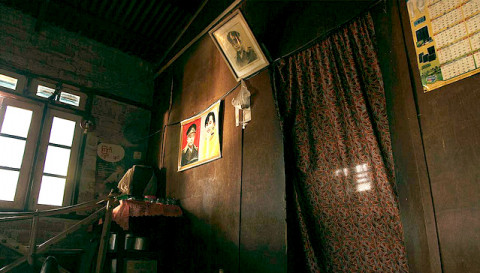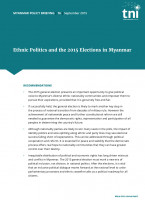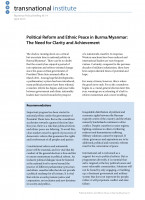The 2015 General Election: A New Beginning?
The resounding victory of the National League for Democracy in the November general election has raised hopes in Myanmar and around the world that, finally, the country could be on the road towards peace and democracy. Sadly, there have been too many failures in the past for simple optimism now. During the past half-century, there have been important highpoints before when expectations were raised that the national armed forces, known as Tatmadaw, would restore democratic rights to the people and nationwide peace might spread in the country.

Clod / Flickr
In recent memory, the 1988 pro-democracy summer, the 1989 ethnic ceasefires, the NLD’s 1990 election victory and the 2007 Saffron Revolution all appeared to herald epoch-shaping changes in the national landscape. But on each occasion, the weeks turned into months as the military authorities prevented socio-political transition from taking place through a combination of obfuscation, repression and delay. Meanwhile armed conflict continued in the ethnic borderlands. The result has been that a Tatmadaw-dominated status quo has continued in many aspects of government and national life until the present day.
Despite such precedents, the early sense is much stronger this time that a sustainable change for the better should be possible in the landscape of national politics following the NLD victory. Such sentiment is widespread in both Myanmar and abroad. Although serious challenges remain, Myanmar is undoubtedly a more liberal and open place than it was when the quasi-civilian government of President Thein Sein assumed office four years ago. The benefits have been quickly obvious, and there is generally deeper acceptance and discussion within the country of the scale of difficulties to be addressed in the achievement of national peace and democracy.
For substantive progress to be made, future success is now very dependent on leaders on the different sides – Tatmadaw, pro-democracy and ethnic nationality – working constructively together rather than seeking personal advantage, as has too often been the case in the past. As at other key moments of national change in 1948, 1962 and 1988, national politics in Myanmar are now entering very uncharted waters.
For the moment, uncertainty is widespread, a situation that could well continue for many months to come. Given the legacy of conflict and divisions in national politics, it is difficult to generalise over everyone’s perspectives and experiences – other than a very clear desire for nationwide change, as evidenced by the NLD victory. In contrast, the pro-Tatmadaw Union Solidarity and Development Party, which formed the basis for the Thein Sein government, was soundly rejected.
Such uncertainty over political directions leaves wide room for speculation. When looking for future pointers, it is possible, for example, to look at the career or nationality backgrounds of the new NLD MPs-elect or the relationships engendered in previous decades of struggle against military government in such alliances as the Committee Representing the People’s Parliament or the borderland National Council Union of Burma, both of which brought previous NLD MPs-elect together with different ethnic nationality movements. Similarly, given its entrenched presence and history in the ethnic borderlands, few nationality leaders expect that the Tatmadaw will accept any significant change in its dominant role in these territories during the life of the next parliament, whatever reforms are attempted by the NLD.
However analysis of the likely policies or tactics by the NLD and other parties in the new parliament is still some way into the future. The USDP-Tatmadaw nexus is also opaque, as military leaders have to consider the potential demise of the party upon which many had staked their future careers. History is now moving on fast, and a formidable array of challenges awaits all Myanmar’s leaders as they test each other out in trying to secure their interests and positions in the country’s political future. As in other times of national change, they face a very fraught task.
In the election aftermath, national legitimacy again resides with Aung San Suu Kyi and the NLD leaders as they seek to build the foundations for what they promise to be a new era of peace and democratic change. First, citizens will be watching how the election result will be delivered in terms of impact on government and the post-2011 system of parliamentary politics introduced by President Thein Sein. Polite words are presently being exchanged, but substantive accommodation will still be necessary between NLD and Tatmadaw leaders if a real transfer of power is to take place by the time a new President and government are supposed to take office next March. As the Irrawaddy magazine wrote after the election: “National reconciliation across ethnic, political and institutional lines is key to Burma’s future. The incumbent president and army chief are integral to that process.”
Then, if and when agreement is achieved between Tatmadaw and NLD leaders, there will be close observation of how the NLD conducts itself in establishing a new government and promoting reforms in the legislatures. Encouraged by the clarity of the election result, there is widespread goodwill in Myanmar and across the international community for the NLD to succeed. In most bodies, the party will have a working majority, despite the reservation of 25 per cent of all seats for Tatmadaw appointees. But there can be few illusions about the complexity of challenges the country is facing after decades of political stasis and ethnic conflict. Any one of these has the potential to cause serious crisis for any incoming government.
Among many outstanding needs, the 2008 constitution has to be reformed which prevents the NLD leader Aung San Suu Kyi from becoming President and inhibits democratic governance; a “nationwide” ceasefire has to be agreed that includes all ethnic armed organisations; political dialogue needs to be initiated about pro-federal reform; Buddhist-Muslim tensions have to be addressed and citizenship rights reviewed; the legacy of land-grabbing, natural resource exploitation and controversial contracts agreed under previous governments has to be addressed; equitable relations must be developed with the international community, not least with China which has sizeable economic interests in the country; and finally, an acceleration has to be made on humanitarian programmes and socio-economic reforms that bring tangible benefit to the country’s peoples. After decades of state failure and national under-achievement, the last thing citizens want is another government of rhetorical promises and crisis management.
Against this formidable backdrop, there can be no hierarchy of needs in the promotion of national reconciliation and democracy. Myanmar’s challenges in political transition and peace-building are those for a generation to address. But of the highest importance in the new government’s endeavours is that, at some stage, democratic processes for parliamentary reform and peace talks for a nationwide ceasefire are brought together. Presently, whether by default or design, these two processes remain on different tracks, but inclusive peace and reform will be impossible unless all communities and parts of the country are able to work together for the common good.
The 2015 general election therefore marks a real opportunity to redouble dialogue and reform efforts in the search for nationwide peace. As the poll results showed, although some ethnic-based parties did well (especially in the region/state legislatures), there can be no doubt about the support amongst Myanmar’s nationality peoples for the NLD to become the new government as a harbinger of democratic reform. Almost repeating its performance in the 1990 general election, the NLD won 79 per cent of electoral seats in the national parliament. Clearly, across the country a vote for the NLD has been cast as a vote for change.
Nevertheless, despite the decisive nature of the NLD victory, there have already been warnings of troubles that could negatively impact on ethnic politics. First, despite the pledges of countrywide peace, during the past year Tatmadaw operations, including aerial strikes, have increased in the Kachin and Shan states, and these attacks escalated after ethnic-based forces in the northeast of the country did not consent in October to sign a partial “nationwide ceasefire” that was non-inclusive and came to involve just eight groups. In essence, with the general election looming, the majority of ethnic armed parties wanted to wait until 2016 when, they hope, a better national landscape for peace can be achieved.
Second, following the poll results, some ethnic nationality parties fear that, once again, their interests could be significantly under-represented due to the country’s “first-past-the-post” voting system. Reasons for their generally lower showing include continuing conflict and the suspension of voting in some areas, inter-ethnic competition, and the national dominance of the two Burman (Bamar) majority parties, the NLD and USDP, both of which were able to run countrywide campaigns. In particular, there is frustration that the NLD chose to contest all electoral seats in the country, despite requests not to do so from ethnic party allies that had struggled alongside the NLD for democratic change through the long years of military rule.
It is important to stress, then, that the NLD includes many ethnic nationality supporters, and Aung San Suu Kyi has moved quickly to assert that the party will promote peace and ethnic representation when in office. The NLD also advocates pro-federal reform. There thus remains every reason to hope that the NLD will prioritise a new era of national reform and inclusion during the next parliament. But it will also be important for the NLD to take note of warnings by veteran nationality leaders from earlier political eras in the past.
Of especial concern, many leaders are critical of the view, which is being expressed again in the election aftermath, that ethnic minority peoples, who make up around a third of the population, are responsible for their own weaknesses and divisions in national politics. Rather, they believe that state failure in Myanmar should be seen the other way round and viewed from the perspective of the perennial inability of political movements among the Burman majority, who have always had control of national government, to establish peace, consensus and an equitable political system to take the country forward after independence from Great Britain in 1948.
Among the Burman majority, the parliamentary era (1948-62) was marked by armed struggle between socialists and communists; Gen. Ne Win’s “Burmese Way to Socialism” (1962-88) was also marked by armed conflict between socialist and communist groups; and the long rule of the previous military government of the SLORC-SPDC (1988-2011) witnessed confrontation and, sometimes, armed conflict between the Tatmadaw and pro-democracy groups. Meanwhile armed struggle has remained endemic in many of the ethnic borderlands where over a dozen nationality groups have continued to pursue pro-federal or autonomous aims in a frequently changing alignment of relationships with the central government and Burman-majority parties.
Seen against this backdrop, the challenge for minority peoples has always been to decide which side to work with among the Burman majority to support peace and political change. This uncertainty has continued into the USDP-Tatmadaw era under President Thein Sein, and it is gaining new ground as NLD and Tatmadaw leaders discuss political transition today. Given the conflict landscape, this has not always been a question of ideology but a real life-or-death choice, reflecting in destroyed communities and the over one million refugees and internally-displaced persons today.
Equally resonant, those looking back for better precedents to AFPFL governments during the democracy era after independence should be aware of the failures that were set in motion when politicians among the Burman majority largely played party politics in the capital Yangon, failed to end armed conflicts, and did not resolve the constitutional crises afflicting the country. Indeed in Myanmar today, within a month of the general election, there are already fears being voiced by ethnic nationality supporters that two parallel societies or a “diarchic” system of administration could develop unless the NLD is really able to make a breakthrough and change the historic imbalances in national politics during the coming years: a relatively democratic environment of governance for the Burman majority in central Myanmar, and continued Tatmadaw and security dominance in the ethnic minority borderlands.
In the coming months, therefore, citizens across the country are hoping that the NLD, with its countrywide mandate, is able to make a truly new beginning in initiating political, ethnic and institutional reform to bring the country together after decades of internal conflict, economic malaise and military rule. Popular momentum presently lies on the NLD side, and ethnic peace and justice are at the centre of its goals for national reform.
But given Myanmar’s troubled history, uncertain and difficult times undoubtedly lie ahead.
This commentary is part of a TNI project funded by Sweden.

